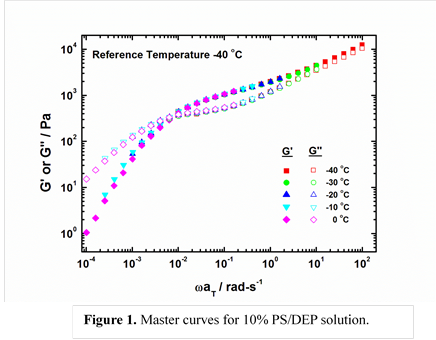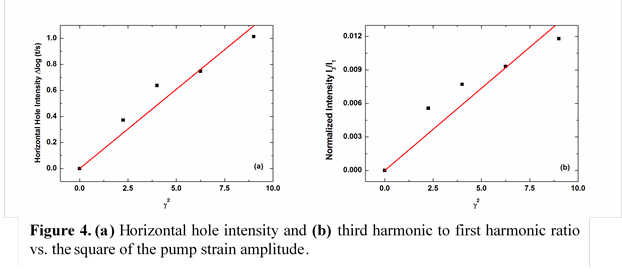Reports: ND753205-ND7: Fingerprinting Non-Linear Response of Star-Branched and Dendritic Polymers: LAOS, Lissajous and Harmonics
Gregory B. McKenna, Texas Tech University
The polymer solution studied in this work is polystyrene (PS)/diethyl phthalate (DEP) solution. The linear PS was purchased from Polymer Source. The molecular weight Mn is 980,000 g/mol and PDI is 1.16. High purity (99.5%) DEP was purchased from Sigma-Aldrich. The 10% PS/DEP solution was prepared following the methods in Qin et al.1. The concentration of the solution was calculated by the mass of the PS and DEP added into the system before evaporation of the cosolvent.
Methods
Mechanical Spectral Hole Burning experiments were performed with a TA Instruments ARES rheometer with a 50 mm diameter and 0.0402 rad angle cone and plate fixture. A custom designed strain gauge transducer (Sensotec) was installed in the ARES. The transducer has a torque range of 20000 g cm and normal force range of 5000 g. Dynamic frequency sweep tests were performed over temperature from 0 ~ -40 ºC and a frequency range of 0.01 ~ 100 rad/s. The MSHB experiments were performed at -40 ºC. Fourier Transform Rheology experiments were performed with the ARES and the raw time data (stress and strain) were digitized using a 16 bit analog to digital high performance converter (ADC) card from National Instruments (PCI-6052E) with a sampling rate of 333 KHz.2, 3 The digitized data were analyzed by using the MITLAOS program provided by G.H. McKinley’s group at MIT.
Results and Discussion
The dynamic response of the solution was investigated in order to obtain the proper frequency range for the MSHB experiments. The master curve is shown in Fig.1. The vertical red dashed lines show the MSHB pump ‘windows’, in which the frequency range is 0.02~0.1 Hz which falls into the Rouse regime, rubbery plateau, or rubbery to terminal transition depending on temperature of test. At -40 °C it is in the transition from Rouse to rubbery. Fig.2 shows the linear and modified shear moduli at different pump strains for the 10% probe MSHB experiments at pump amplitudes to 300%. The MSHB results shown in Fig.3 (a) show incomplete vertical holes for the different pump amplitudes. These can be attributed to the shear softening in the short time regime. Fig. 3(b) clearly shows complete horizontal holes at different pump amplitudes, which is consistent with heterogeneous dynamics at the test frequency. The results also show that the intensity of the hole increases as the pump amplitude increases and shifts to longer time. We also plotted the horizontal hole intensity vs. the square of pump amplitude (Fig. 4(a)) and find a linear relationship. Similar results of a quadratic dependence for dielectric spectral hole burning were reported by Schiener et al. 4, 5. We also found a linear relationship between the square of pump amplitude and the third harmonic to first harmonic ratio from the FTR. We also found (Fig. 3(a)) that the curves do not merge at long times. This is different from Qin and McKenna’s work1 and Shamim and McKenna’s work6 and we attribute the difference to be due to the use of a less sensitive transducer than in those works. The result is that the zero drift at long times leads to some uncertainty in the long-time hole burning response. 0 Upon applying larger pump and probe stain amplitudes (to increase the accuracy of the long
time results) we find better convergence towards zero in the hole relaxation response and this is shown in Figure 5 for a 30% probe strain and different pump strain amplitudes. In Fig. 5(a), incomplete vertical holes are observed. The curves overlap with each other in the longer time regime except in the case of the 300% pump run, indicating the larger amplitudes gave better, results. Complete horizontal holes at different pump amplitudes are shown in Fig. 5(b). The hole intensity increases with the pump and shifts towards longer times.
Conclusions
The nonlinear response of a 10% PS/DEP solution in the Rouse regime was investigated by Mechanical Spectral Hole Burning. Due to shear softening at short times, incomplete vertical holes are observed. At the same time complete horizontal holes are formed, consistent with heterogeneous dynamics in the test frequency range. The horizontal hole intensity and normalized third harmonic intensity show a quadratic dependence on the pump amplitude.
Work in Second Year of Grant
The current results show dynamic heterogeneity as probed by the mechanical hole burning in linear PS/DEP solution. Further experiments will focus on the MSHB experiments on hyperbranched polymer solutions. The polymers we are interested in are hyperbranched PS and Polybutadiene (PBD). The nonlinear response of hyperbranched PS (or PBD) will be compared with the linear PS (or PBD). The dependence of the branching frequencies and branch molecular weight will be investigated. The results will be compared with the behaviors from Fourier Transform Rheology and with the Fingerprinting approach to Lissajous loops in the MITLAOS methodology. References
1. Qin, Q.; Doen, H.; McKenna, G. B. J Polym Sci Pol Phys 2009, 47, (20), 2047-2062.
2. Wilhelm, M.; Maring, D.; Spiess, H. W. Rheol Acta 1998, 37, (4), 399-405.
3. Wilhelm, M. Macromol Mater Eng 2002, 287, (2), 83-105.
4. Schiener, B.; Bohmer, R.; Loidl, A.; Chamberlin, R. V. Science 1996, 274, (5288), 752-754.
5. Schiener, B.; Chamberlin, R. V.; Diezemann, G.; Bohmer, R. J Chem Phys 1997, 107, (19), 7746-7761.
















